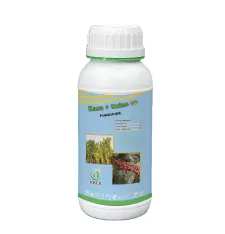
Jul . 21, 2025 14:09 Back to list
Using Herbicide Effective Weed Control in Modern Agriculture
Weeds are among the most persistent challenges farmers face, competing with crops for nutrients, water, and sunlight. Effective groundnut herbicide use is essential for protecting and effective cultivating in organic herbicides for weeds.
This comprehensive guide explores different types of herbicides, including ethofumesate herbicide, organic herbicides for weeds, and specialized groundnut herbicide, providing farmers with the knowledge they need to make informed decisions for weed management.

Understanding Ethofumesate Herbicide: A Selective Solution for Crop Protection
Ethofumesate herbicide is a selective pre- and post-emergent herbicide widely used in sugar beets, turfgrass, and certain vegetable crops. It works by inhibiting cell division in weeds, effectively controlling grassy and broadleaf weeds without harming the main crop.
Key Benefits of Ethofumesate Herbicide
✔ Long-lasting residual control – Suppresses weed growth for extended periods.
✔ Selective action – Safe for sugar beets, onions, and certain grasses.
✔ Effective against tough weeds – Controls wild oats, blackgrass, and other problematic species.
Application in Major Crops
Sugar Beets – Applied pre-emergence to prevent early weed competition.
Onions & Carrots – Used post-emergence for selective weed control.
Turf Management – Keeps golf courses and lawns weed-free.
Compared to non-selective herbicides, ethofumesate herbicide offers precision weed control, making it a preferred choice for high-value crops.
Organic Herbicides for Weeds: A Sustainable Approach to Weed Management
With increasing demand for sustainable farming, organic herbicides for weeds have gained popularity. These herbicides are derived from natural sources and are ideal for organic farms, home gardens, and eco-conscious agriculture.
Types of Organic Herbicides
Vinegar-Based (Acetic Acid) – Burns weed foliage on contact.
Corn Gluten Meal – Prevents weed seed germination.
Essential Oil Blends (Clove, Citronella, Peppermint) – Disrupt weed cell membranes.
Best Uses in Farming
Vegetable Farms (Tomatoes, Peppers, Lettuce) – Spot treatment for weeds between rows.
Fruit Orchards (Apples, Oranges) – Keeps weed pressure low without synthetic chemicals.
Rice & Wheat Fields – Used in organic rotations to reduce chemical dependency.
While organic herbicides for weeds may require more frequent applications than synthetic options, they provide a safe, residue-free alternative for sustainable farming.
Groundnut Herbicide: Protecting Peanut Crops from Competitive Weeds
Peanuts (groundnuts) are highly susceptible to weed competition, which can drastically reduce yields. A specialized groundnut herbicide is essential for maintaining healthy peanut crops.
Best Herbicide Options for Peanuts
Pre-Emergent Herbicides – Prevent weed seeds from sprouting.
Post-Emergent Herbicides – Target established weeds without harming peanuts.
Selective Grass Killers – Control grassy weeds while sparing broadleaf crops.
Application Techniques
Pre-Planting Treatment – Ensures a weed-free seedbed.
Early Post-Emergence – Targets young weeds before they compete with peanuts.
Mid-Season Spray – Controls late-germinating weeds.
Using the right groundnut herbicide improves peanut yield, pod quality, and harvest efficiency, making it a crucial tool for peanut farmers.
Herbicide Application in Key Crops: Corn, Wheat, Rice, Soybeans, and More
Different crops require tailored herbicide strategies for optimal weed control. Below are the best practices for major crops:
A. Corn & Soybeans
Pre-Emergent Herbicides – Stop weeds before they emerge.
Post-Emergent Herbicides – Target escaped weeds in growing crops.
B. Wheat & Rice
Broadleaf Weed Control – Essential in wheat fields.
Aquatic Weed Management – Specialized herbicides for rice paddies.
C. Fruits & Vegetables (Potatoes, Onions, Peppers, Apples, Oranges)
Selective Herbicides – Avoid crop damage.
Organic Options – For residue-free produce.
D. Sugarcane
Long-Residual Herbicides – Prevent weeds in dense sugarcane fields.
A well-planned groundnut herbicide program ensures higher yields, better crop quality, and reduced labor costs.
FAQs About Herbicides
1. What is the best herbicide for groundnut (peanut) fields?
A selective groundnut herbicide with pre- and post-emergent action is ideal for peanuts, ensuring weed-free growth without crop harm.
2. Are organic herbicides for weeds as effective as synthetic ones?
While organic herbicides for weeds may require more frequent use, they provide eco-friendly, residue-free weed control, ideal for organic farming.
3. Can ethofumesate herbicide be used in vegetable crops?
Yes, ethofumesate herbicide is safe for onions, carrots, and certain leafy vegetables, offering selective weed control.
4. How soon can I plant after applying herbicides?
This depends on the herbicide. Some allow immediate planting, while others require a waiting period—always check the label.
5. What’s the best way to prevent herbicide resistance?
Rotate herbicide modes of action, use tank mixes, and integrate mechanical weeding to reduce resistance risks.
-
Tembotrione Mode of Action in Weed Control
NewsJul.21,2025
-
Safety Guidelines for Handling Atrazine in Farming
NewsJul.21,2025
-
Mesotrione Residue Management in Crops
NewsJul.21,2025
-
How Topramezone Controls Resistant Weed Species
NewsJul.21,2025
-
How to Properly Handle Glufosinate Ammonium
NewsJul.21,2025
-
Best Practices for Applying 2 4d Herbicide
NewsJul.21,2025
